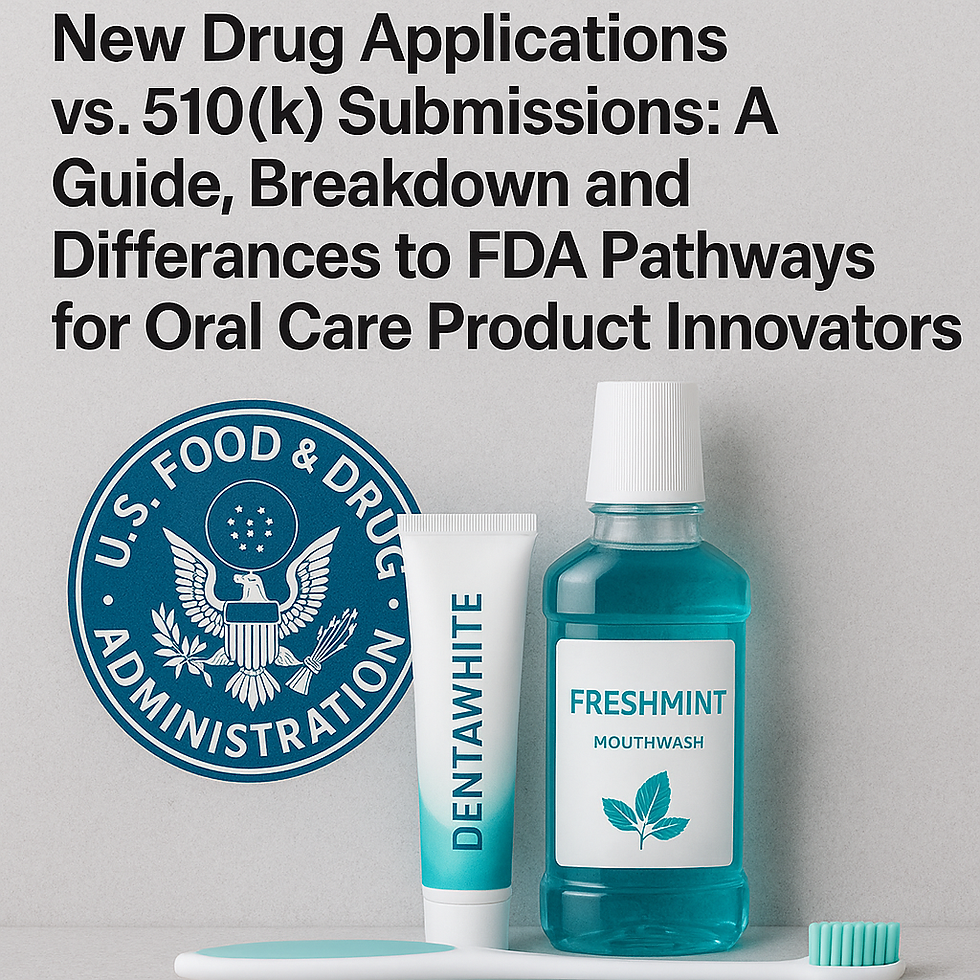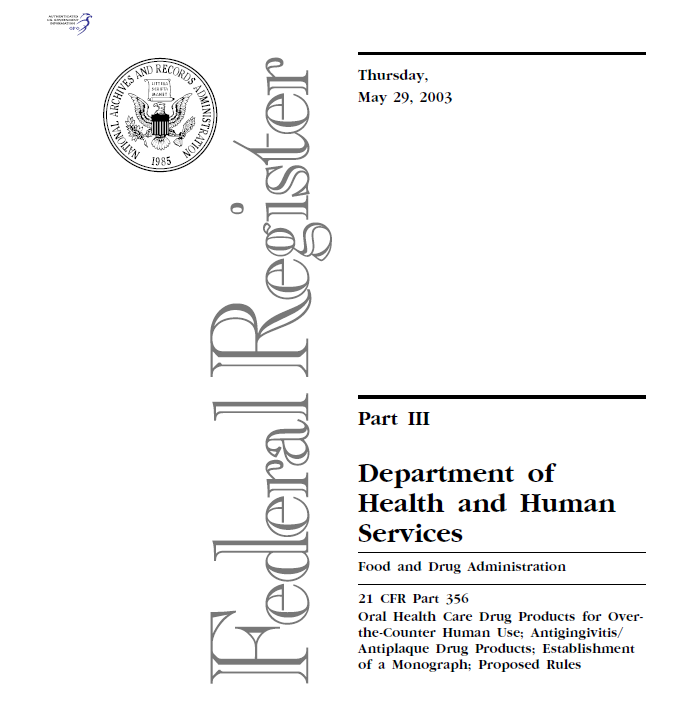New Drug Applications vs. 510(k) Submissions: A Guide, Breakdown and Differences to FDA Pathways for Oral Care Product Innovators
- Evan Howard
- Jun 16, 2025
- 6 min read
If you’re innovating in the oral care space, whether you’re developing a new mouth rinse, a high-tech toothbrush, a dental appliance, or a novel toothpaste, understanding the FDA’s regulatory pathways is essential. The two main routes you’ll encounter are the New Drug Application (NDA) and the 510(k) premarket notification. These processes are fundamentally different, and picking the right one can mean the difference between a smooth launch and years of regulatory headaches.
Let’s break down what each path means for oral care innovators, why the distinction matters, and how to navigate the FDA’s expectations with confidence.

The Regulatory Landscape for Oral Care Products
Oral care products are unique because they can fall into several regulatory categories: cosmetic, drug, device, or even a combination of the two. The FDA classifies products based on intended use, claims, and how they work. For instance, a toothpaste that claims to “whiten teeth” for cosmetic purposes is regulated differently than one that claims to “prevent cavities” or “treat gingivitis,” which are considered drug claims.
Similarly, a mouthguard or dental appliance or a toothbrush is a device, while a rinse that claims to reduce plaque by physical means may also be regulated as a device.
Understanding where your product fits is the first step. If you’re making a claim that your product treats, prevents, or mitigates a disease or health condition (like “prevents gingivitis” or “reduces dental plaque”), you’re likely in drug or device territory. If your product works by physical means and is substantially similar to something already on the market, the 510(k) process might be your path. If it works by chemical action or makes therapeutic claims not covered by an existing OTC monograph, you may need to pursue an NDA.
What Is a 510(k) and When Does It Apply to Oral Care?
The 510(k) pathway is all about medical devices. In the oral care world, this includes things like dental appliances, mouthguards, certain kinds of toothbrushes, and even oral rinses that work by physical means to reduce the adhesion of dental plaque. The key to the 510(k) is “substantial equivalence.” You need to show that your product is as safe and effective as a legally marketed “predicate” device (one that’s already been cleared by the FDA).
For example, if you develop a new oral rinse that physically disrupts plaque so it can’t stick to teeth, and there’s already a similar rinse on the market, you can use the 510(k) process. This involves compiling data to demonstrate that your product performs at least as well as the predicate in terms of safety and effectiveness. The FDA will want to see bench testing, performance data, and sometimes limited clinical data, but you won’t have to run the kind of large-scale clinical trials required for drugs.
The 510(k) process is generally faster and less expensive than the NDA route. You’ll submit your data, labeling, and a comparison to the predicate device. The FDA reviews your submission, and if they agree your device is substantially equivalent, you get clearance to market it. For oral care devices, this is the most common path unless your product is truly novel or high-risk.
What Is a New Drug Application (NDA) and When Is It Required?
The NDA is the FDA’s process for approving new drugs. In oral care, this applies to products that contain active ingredients intended to diagnose, cure, mitigate, treat, or prevent disease (and that don’t fit into an existing OTC monograph). For example, if you’re developing a new mouth rinse with a novel active ingredient that claims to treat periodontitis, or a toothpaste with a new anti-caries agent, you’re in NDA territory.
The NDA process is rigorous. You’ll need to provide extensive data from preclinical studies, followed by human clinical trials in three phases to demonstrate safety and efficacy. You’ll also need to submit detailed information on manufacturing, chemistry, labeling, and more. The FDA will review all this information, inspect your manufacturing facilities, and may require additional studies before approval.
This route is time consuming and expensive, but it’s necessary for products that make therapeutic claims not covered by an OTC monograph or for those introducing new active ingredients. For oral care innovators, the NDA is usually reserved for breakthrough products that promise significant advances in oral health.
OTC Monographs: The Middle Ground
Many oral care drugs, like fluoride toothpastes or certain mouth rinses, are regulated under OTC monographs. These are “recipes” established by the FDA that allow products with specific active ingredients, concentrations, and claims to be marketed without an NDA. If your product fits within an existing monograph (ex: a fluoride toothpaste that claims to prevent cavities), you don’t need to go through the NDA process. However, if you want to make a new claim (“prevents plaque” or “treats gingivitis”) or use a new active ingredient, you’ll need to either amend the monograph (a long process) or pursue an NDA.
Real-World Examples for Oral Care Innovators
Let’s say you’re developing an oral rinse. If your rinse works by physically disrupting plaque and there’s already a similar device on the market, you’d likely go the 510(k) route. You’d gather your performance data, compare your product to the predicate, and submit your 510(k) to the FDA. If cleared, you can market your rinse with claims like “reduces the adhesion of dental plaque by physical means”.
If, on the other hand, your rinse contains a new antimicrobial agent and you want to claim it “prevents gingivitis,” you’re looking at an NDA. You’ll need to conduct clinical trials, prove safety and efficacy, and submit a comprehensive NDA package for FDA review.
For something like a new toothpaste, if you stick to fluoride and claims allowed by the OTC monograph (“helps prevent cavities”), you’re in the clear. If you want to claim your toothpaste “prevents plaque” and your formulation isn’t covered by the monograph, you may need to submit an NDA.
The ADA Seal of Acceptance: Another Layer
While not an FDA requirement, many oral care innovators seek the American Dental Association (ADA) Seal of Acceptance. This seal is a mark of scientific credibility and consumer trust. To earn it, you’ll need to submit clinical and laboratory data proving your product’s safety and efficacy for its intended use. The ADA’s standards often mirror or exceed FDA requirements, and the review is conducted by dental experts. Products with the ADA Seal are more likely to be recommended by dental professionals and trusted by consumers.
Key Differences Summarized for Oral Care Innovators
The 510(k) process is for devices, is faster, and relies on demonstrating equivalence to an existing product. It’s ideal for new iterations of mouthguards, oral appliances, or rinses that work by physical means. The NDA process is for drugs, is more demanding, and requires original clinical data. It’s necessary for new active ingredients or novel therapeutic claims not covered by an OTC monograph.
For most oral care startups, the 510(k) is the route for devices and physical-action rinses, while the NDA is reserved for big, innovative leaps in oral health drugs. If your product fits an OTC monograph, that’s the simplest path. If not, be prepared for the time and investment required for an NDA.
Practical Tips for Oral Care Product Developers
Define Your Claims Early: Your marketing claims determine your regulatory path. “Whitens teeth” is cosmetic. “Prevents cavities” is a drug claim. “Reduces plaque by physical means” is a device claim.
Check for Predicates: For devices, find a predicate product. This makes the 510(k) process much smoother.
Know the Monographs: If your product fits an OTC monograph, you can avoid the NDA process. If not, plan for more extensive studies.
Plan for ADA Submission: If you want the ADA Seal, build their requirements into your development process from the start.
Consult the FDA Early: The FDA’s pre-submission process can clarify expectations and prevent costly missteps.
Why This Matters
For oral care innovators, understanding the difference between the NDA and 510(k) processes is crucial for efficient product development, regulatory compliance, and successful market entry. The right strategy saves time, money, and frustration—and ensures your product reaches consumers safely and effectively.
Whether you’re launching a new dental device, a novel mouth rinse, or a next-generation toothpaste, knowing your regulatory pathway is as important as your product’s science. With the right approach, you can navigate the FDA’s requirements, earn professional endorsements, and build consumer trust in your innovation.
Howard Law is a business, regulatory and M&A law firm in the greater Charlotte, North Carolina area, with additional services in M&A advisory and business brokerage. Howard Law is a law firm based in the greater Charlotte, North Carolina area focused on business law, corporate law, regulatory law, mergers & acquisitions, M&A advisor and business brokerage. Handling all business matters from incorporation to acquisition as well as a comprehensive understanding in assisting through mergers and acquisition. The choice of a lawyer is an important decision and should not be based solely on advertisements. The information on this website is for general and informational purposes only and should not be interpreted to indicate a certain result will occur in your specific legal situation. Information on this website is not legal advice and does not create an attorney-client relationship. You should consult an attorney for advice regarding your individual situation. Contacting us does not create an attorney-client relationship. Please do not send any confidential information to us until such time as an attorney-client relationship has been established.




Comments